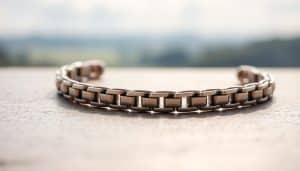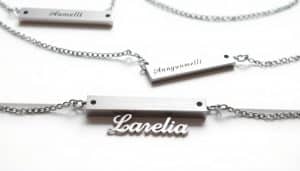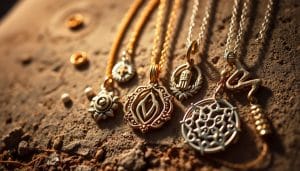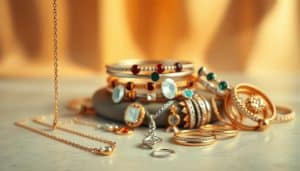PVD Jewelry: Understanding the Benefits and Drawbacks
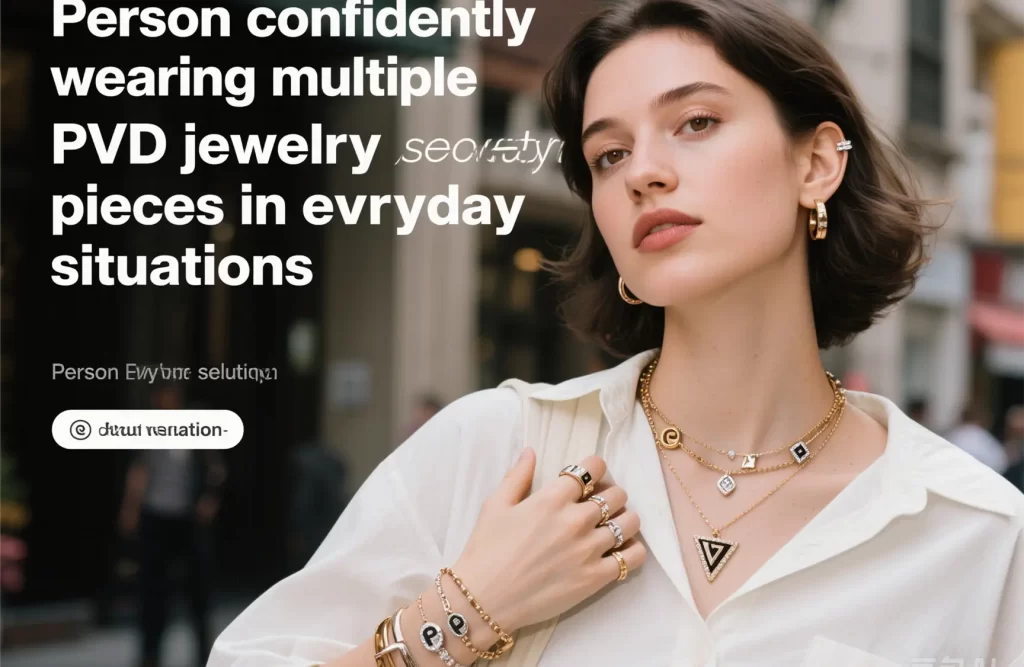
PVD Jewelry: Understanding the Benefits and Drawbacks
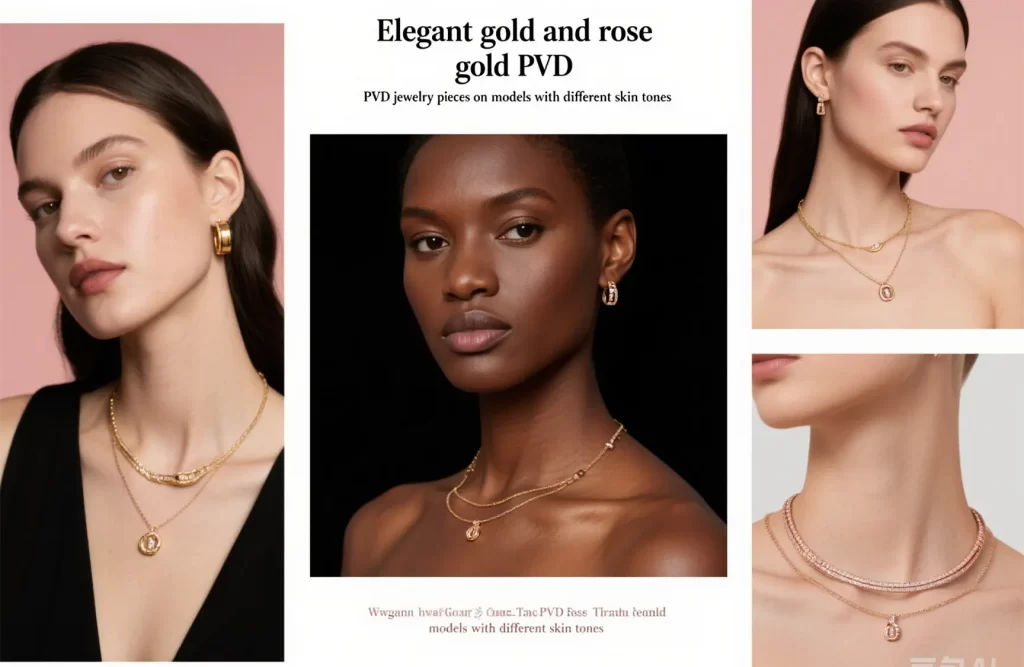
PVD refers to the process of applying a hot, strong coating to jewelry that is known as physical vapor deposition. I work through this process to make my pieces uniformly hard, bright, and long-lasting.
With PVD, materials such as stainless steel or titanium receive a durable finish that prevents scratches and fading. You end up with jewelry that won’t tarnish as quickly and maintains its sheen, despite everyday use.
Because PVD is nonreactive, PVD-coated pieces remain safe for skin, meaning people with metal allergies can wear them without fear of exposure. In Los Angeles, I find that more people are choosing PVD jewelry for their aesthetic appeal and their economical benefits.
My goal through this blog is to share simple truths behind PVD jewelry with you. Let me tell you what sets it apart and how it can improve your world. The following sections take it one step at a time.
What Is PVD Jewelry?
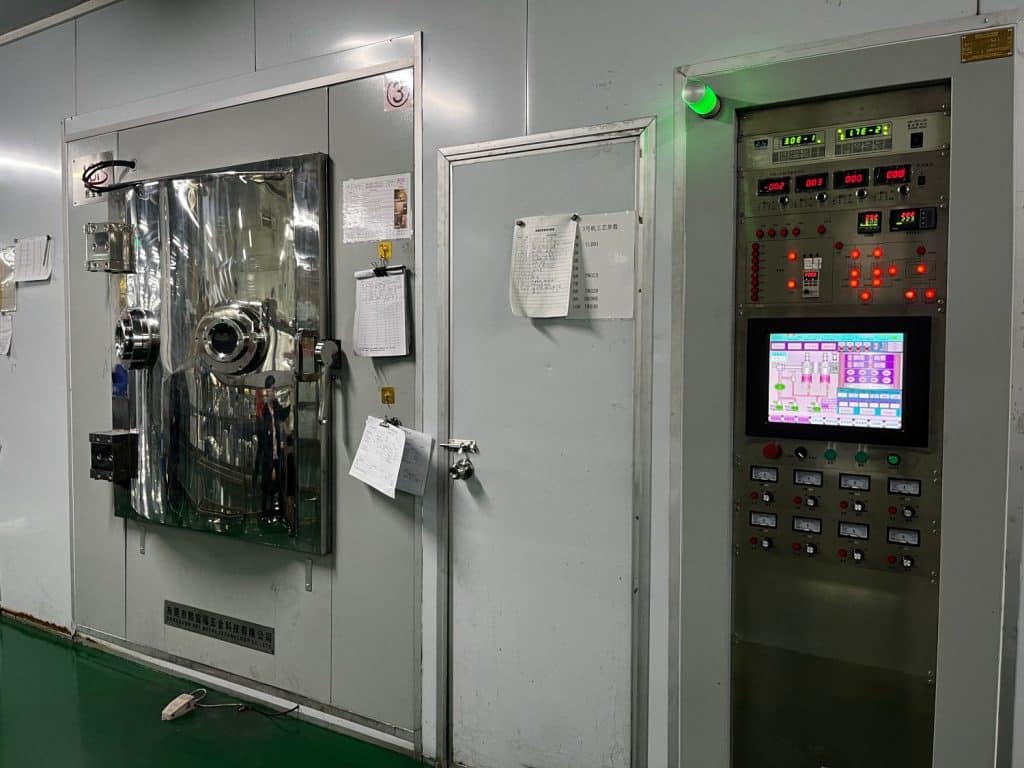
PVD jewelry stands for “Physical Vapor Deposition” jewelry, and it’s an amazing advancement in contemporary jewelry making. This gives you jewelry that has a hard, durable layer that bonds deeply to the metal underneath.
We use a high-vacuum chamber to extremely vaporize a small variety of metals. Next, the vapor bonds with the jewelry, forming a durable and uniform layer. This ensures the color remains vibrant and does not wear off quickly as with traditional plating methods.
You’ll find all sorts of colors, from traditional gold and silver to fabulous rose gold and modern black. This variety is due to the different metal combinations and gases used in the PVD production process.
1. The Science Behind PVD Coating
During the PVD coat process, we super heat metals to a vapor state. As that vapor cools, it condenses onto the jewelry, creating an incredibly durable, solid, thin layer.
Gases such as nitrogen and argon blend in, allowing us to achieve a wide variety of colors and finishes. Prior to coating, we clean and prepare the substrate.
With our patented application process, this step is key for a uniformly smooth, durable finish. With that new tech, we achieve a tough, scratch-resistant surface that is far superior to traditional plating.
2. How PVD Coats Your Jewelry
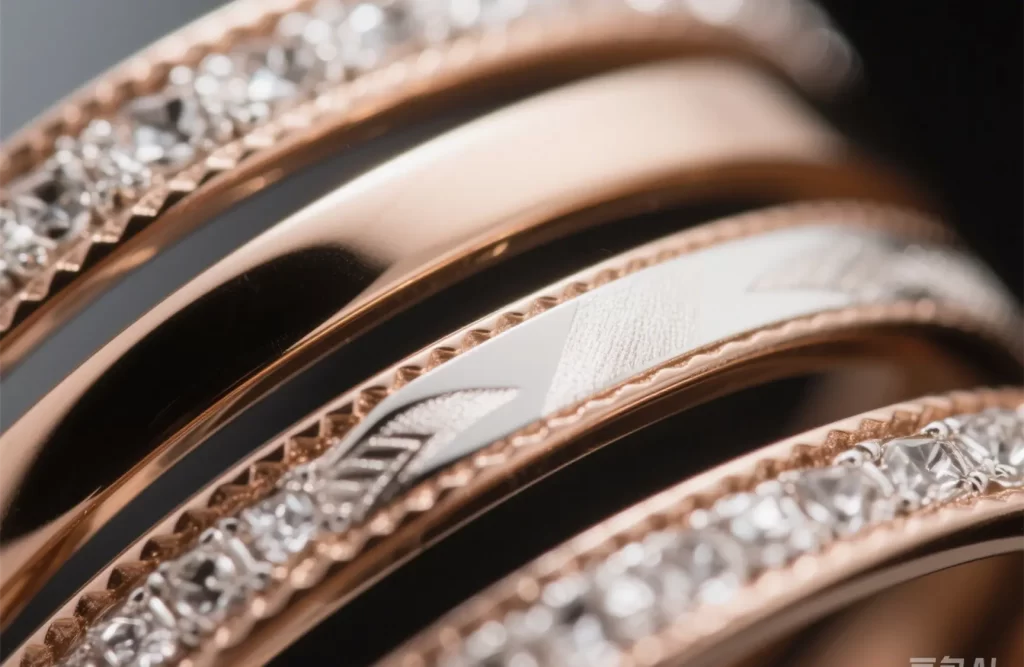
First, we clean and prep each piece of jewelry. In the vacuum, metals are allowed to vaporize, then the vaporized metal molecules adhere to the piece.
Purity is essential in this process in order to make the layer hard and smooth. Since the coating bonds at the atom level, it will never peel or chip.
We use a variety of molds and equipment to regulate the finish and appearance.
3. Common Base Metals Used
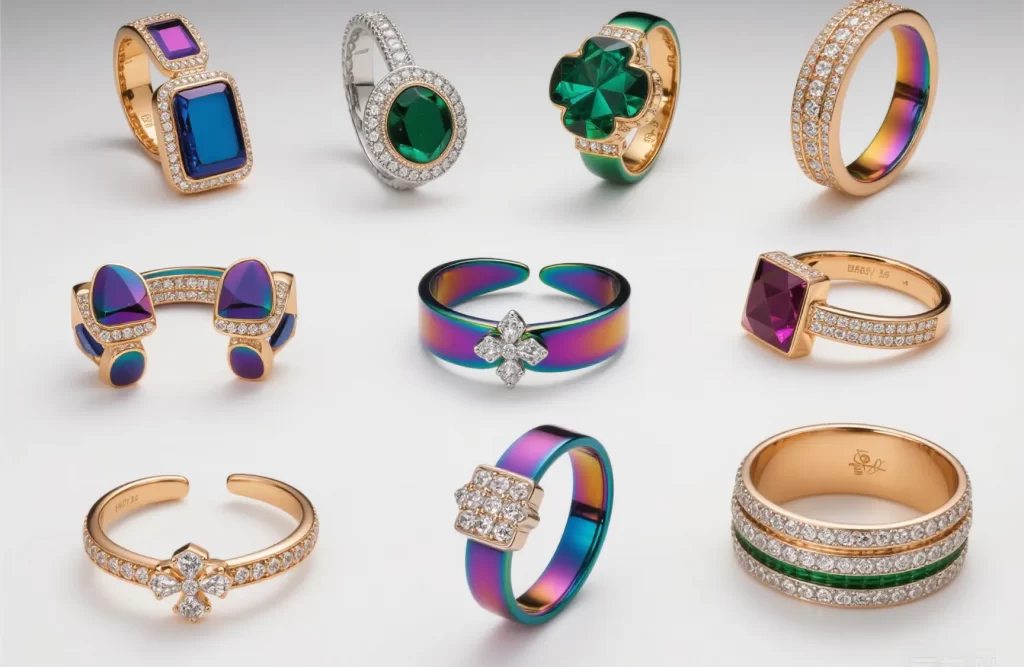
Stainless steel and titanium are both popular choices, but brass and silver are quite common. These metals don’t rust and are metals that can easily be treated in the PVD process.
They’re hypoallergenic and help the final product last longer, too. HonHo Jewelry from China uses stainless steel, brass, and 925 silver, featuring solid, waterproof, and non-fading products.
4. PVD vs. Traditional Plating Methods
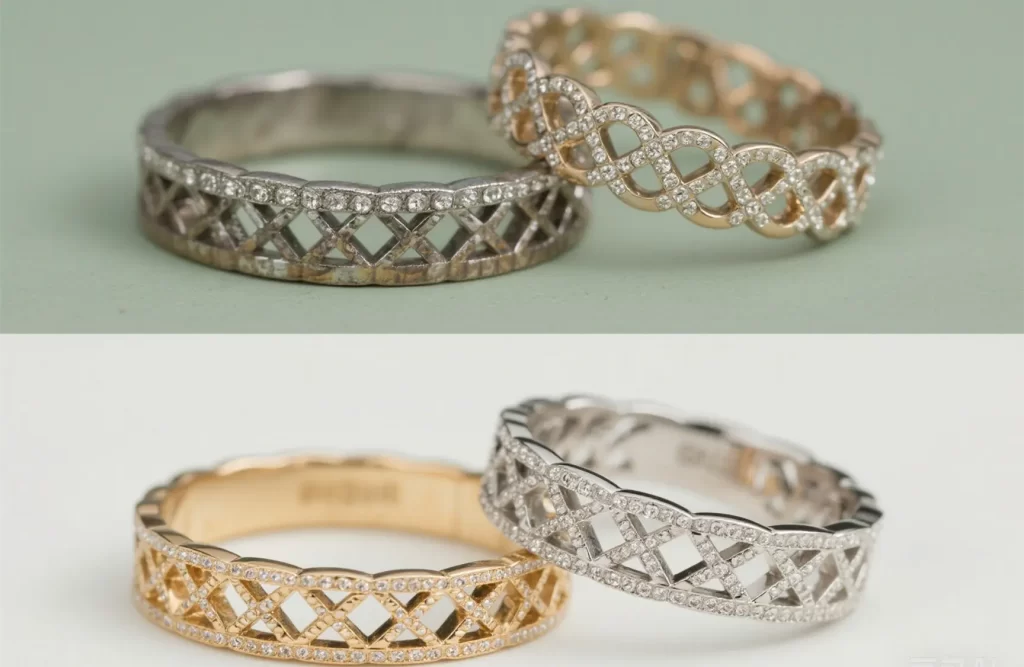
The PVD coating process results in a resilient coating that lasts longer and withstands wear better than traditional gold plating, which often chips or peels. This advanced coating technology provides a beautiful, long-lasting finish that keeps your jewelry pieces bright and new, making it an excellent choice for everyday wear.
Furthermore, PVD layers are 5-10 times tougher than conventional coatings and won’t tarnish, ensuring your jewelry collection maintains its pristine appearance while offering enhanced durability.
5. Is PVD Coating Real Gold?
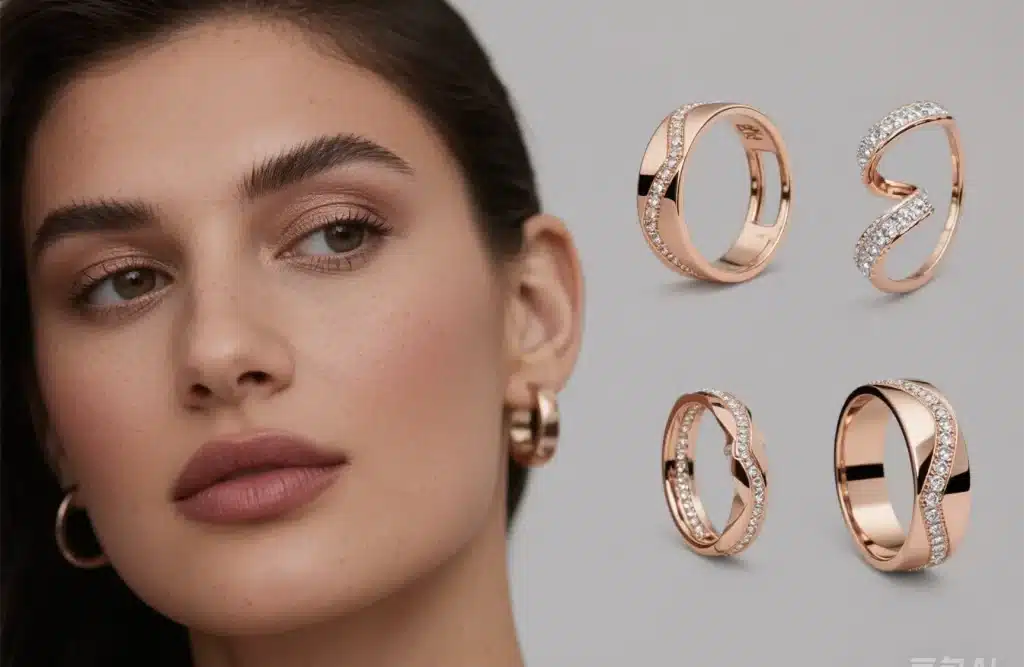
PVD gold jewelry may not be solid gold, but it sure does shine. That’s because the gold layer—while tiny—is durable and adheres firmly to the surface, maintaining its luster.
It’s not “fake”— it’s simply not solid. Most people can’t tell the difference.
6. Understanding “ElectronicPlating” Jewelry
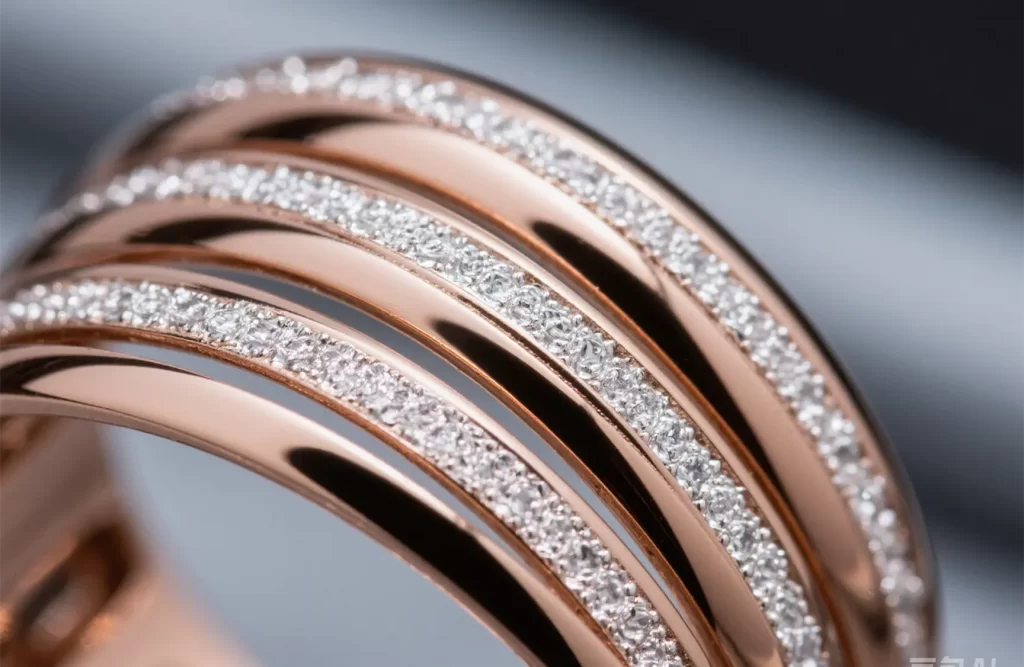
Understanding “ElectronicPlating” Jewelry It’s different than PVD coated, but both have the same idea that a durable, thin layer is fused to the metal underneath.
You can identify ElectronicPlating jewelry by the color spectrum and that they don’t seem to tarnish or flake away.
Why Choose PVD Jewelry?
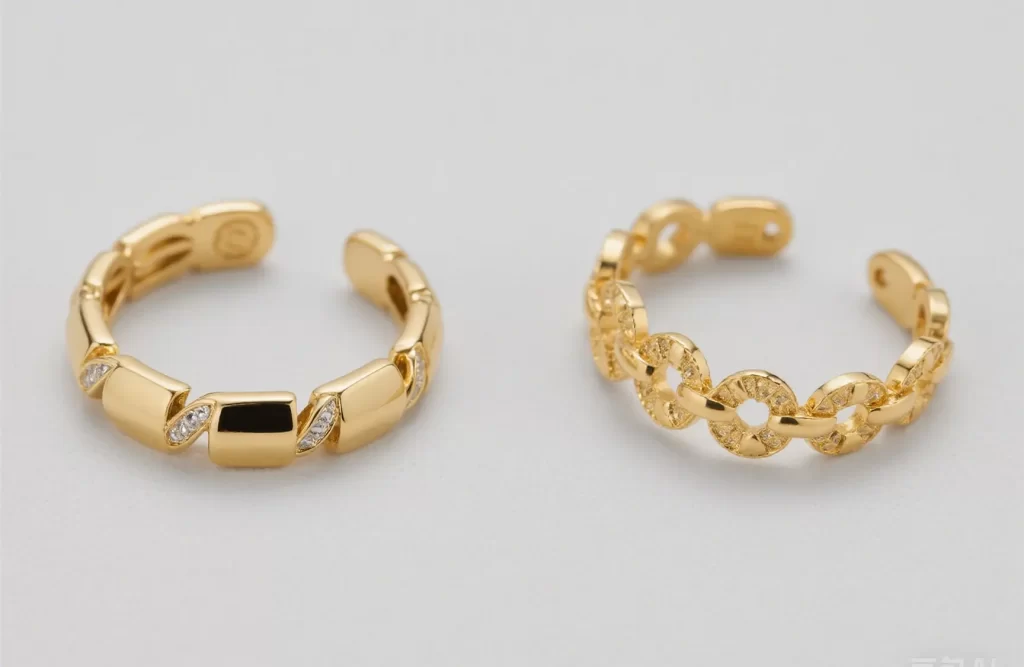
PVD jewelry really makes the best choice for savvy shoppers looking for a unique mix of style, strength and comfort. It’s more than a cosmetic issue. You’ll know you made the right decision with vivid, brilliant color options, genuine long-lasting durability and a safer choice for those with sensitive skin.
The method employs physical vapor deposition to produce a finish 5x harder than traditional plating. That’s why each piece stands the test of time against everyday wear—rain or shine, work or play.
Unmatched Durability: My Experience
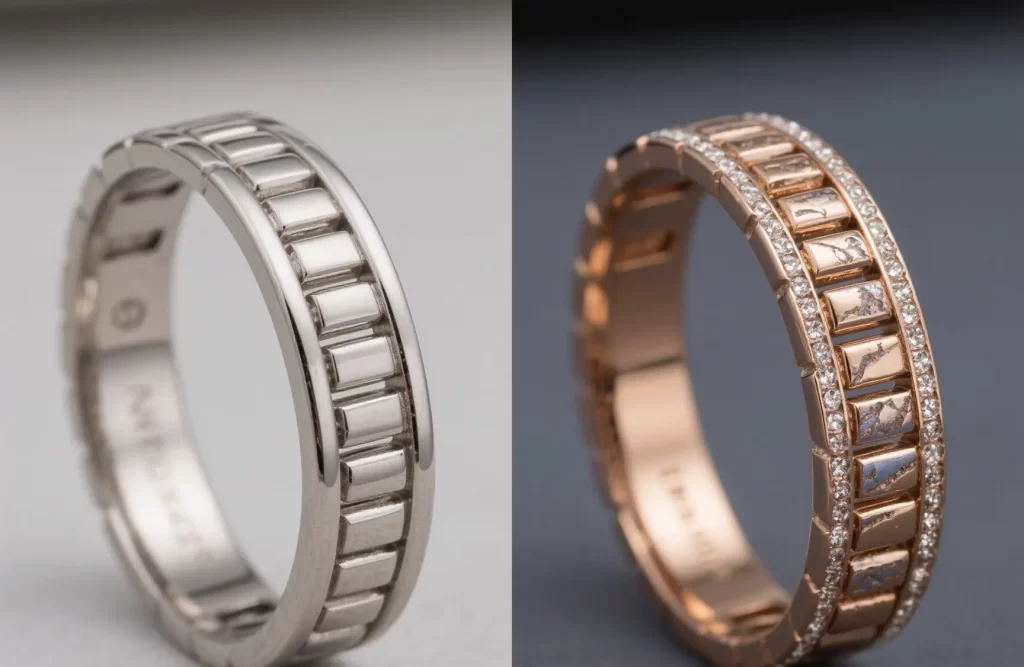
In my experience over the years of wearing PVD jewelry, I have witnessed pieces withstand sandy beach trips, sweaty gym sessions, and hectic work weeks. The coating remains smooth to the touch, with colors appearing vibrant even after several months of wear.
As an illustration, this HonHo gold-tone ring, which I’ve worn every day for about a year, continues to sparkle. This kind of durability is important when you’re investing in a piece of jewelry that you want to look new for years, not months.
A Hypoallergenic Choice We Trust
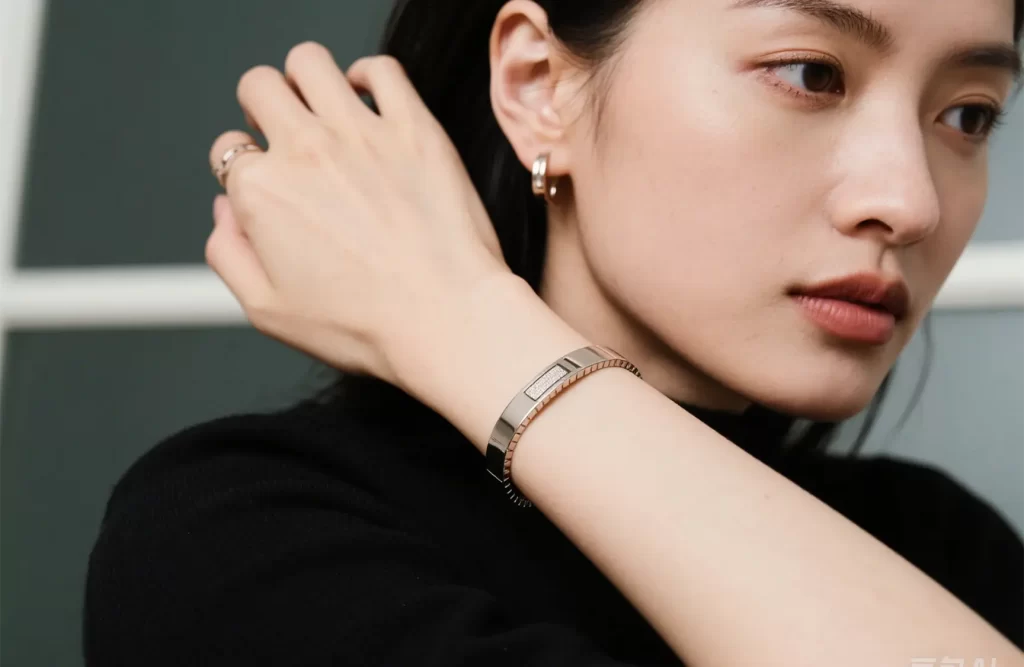
If you have sensitive skin, PVD jewelry is the ideal option. The PVD coatings are made with metals such as titanium or zirconium. They don’t cause skin rashes or irritation as some lower quality alloys do.
The majority of our customers who have metal allergies are wearing PVD earrings and PVD bracelets every single day, without issue.
Vibrant, Fade-Resistant Colors
You can get PVD jewelry in gold, silver, rose gold, gunmetal, blue and purple. These colors are not susceptible to washing out or fading quickly like typical finishes.
Colors such as rich navy or gentle blush pink remain striking, turning every item into an exquisite and dependable complement.
Say Goodbye to Tarnish
With PVD coatings, your pieces will stay bright and shiny, without tarnish. Just a soft cloth and a little mild soap will do!
This saves a lot of time and helps jewelry look fresh and clean.
An Eco-Conscious Finishing Touch
The PVD coating process produces less waste and utilizes fewer noxious chemicals, enabling HonHo and other leading brands to create jewelry pieces that not only exhibit aesthetic appeal but also align with eco-friendly principles.
Potential PVD Jewelry Downsides
Though the PVD coating process does offer unique benefits in terms of durability and aesthetic appeal, there are legitimate drawbacks to consider before you purchase quality PVD jewelry. Understanding the coating properties and the associated price tag is essential, as it helps you make an informed decision about what jewelry pieces work best for you.
Higher Initial Investment?
You may find that PVD jewelry has a higher initial investment than plated or anodized jewelry. This is mainly because of the slower, more complicated process involved and the superior finish it provides.
Sure, you’ll spend a little more in the beginning, but that investment returns dividends. The durable coating bonds deeply, so you can be sure it’ll keep its luster longer. Over a period of years you end up spending less on repairs or replacements compared to less expensive, plated alternatives.
For people who are looking for strong, durable pieces of jewelry, the higher upfront investment is more justifiable over time. At HonHo, we have found that the majority of customers can justify the return in terms of less frequent touch-ups and fading.
Repairing Deep Scratches
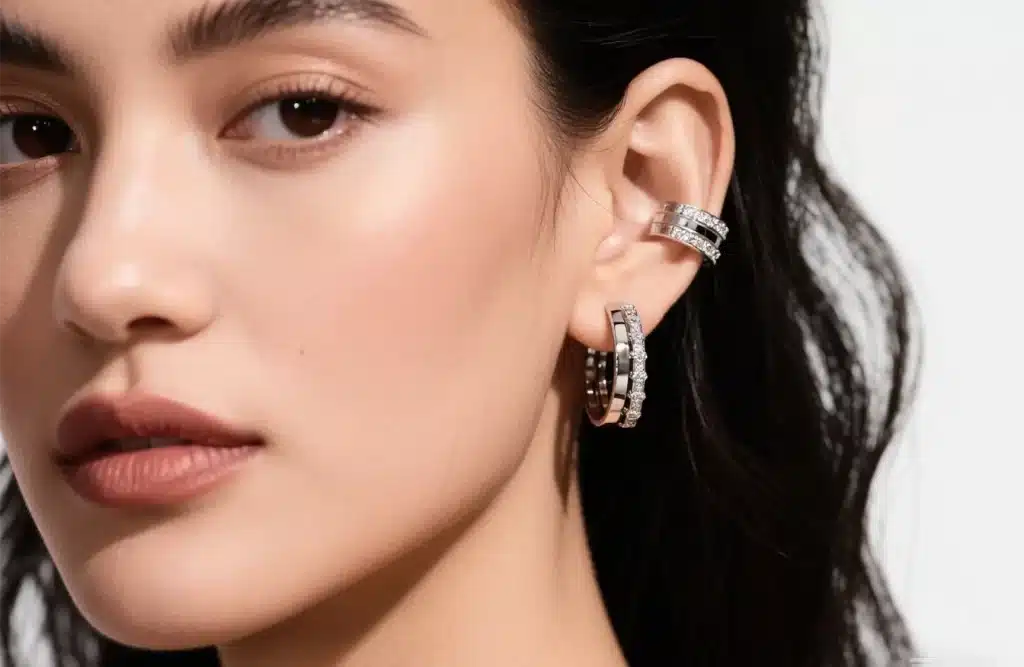
When it comes to PVD jewelry downsides, repairing deep scratches is definitely one to mention. Basic push polishers won’t do the trick and sometimes even the best touch-up coat repair may not match perfectly.
If deep scratches require a professional to re-coat the jewelry, that’s more time and expense. To prevent unsightly scratches from occurring in the first place, avoid abrasive surfaces and store jewelry individually.
Just make it a habit to wipe them down every week or two. We’ve found that with a regular maintenance routine you can achieve amazing results with a clean, bold shine.
Coating Thickness Matters
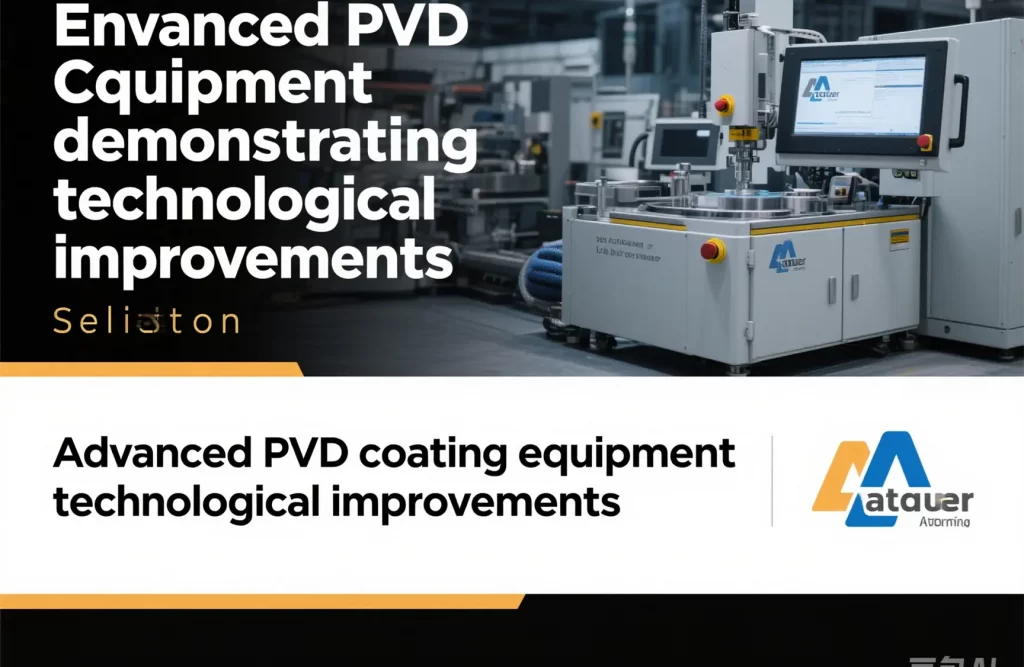
How deep the PVD coating is has a significant impact on whether the jewelry will wear. Thin coatings are prone to micro-abrasions, particularly if you wear your jewelry in harsher environments.
While thicker coatings provide more protection, they do come at a higher price. Check the details before you make a purchase to ensure you’re getting quality jewelry.
When it comes to daily wear, a thicker coating pays off, providing you with more value and a longer lifespan.
PVD Coated vs ElectronicPlating
When discussing PVD jewelry within the United States, you might come across the phrases “PVD coated” vs “ElectronicPlating.” These terms may all sound alike, but there are legitimate differences. Yes, both PVD coated and ElectronicPlating use a process known as Physical Vapor Deposition.
The process they use and the outcomes they produce are completely misaligned. Read on to find out what sets them apart from each other. We’re going to break down what you can expect from each and how that affects care and style.
Defining “PVD Coated” Clearly
PVD coated jewelry has a rich, colorful surface layer. This layer is formed by vapourising the metal and bonding it directly onto the base. This is not just a thin wash—PVD coatings can be an order of magnitude thicker than your grandma’s old-school gold plating.
That extra layer is what makes PVD jewelry so durable. It’s no match for everyday abrasion, perspiration, chlorinated environments, and the rare jaunt through the dishwasher. The color remains vivid considerably longer, and the surface resists scratches more effectively.
If you have piercings in high-movement areas such as cartilage or belly buttons, PVD coated jewelry is an excellent option. They remain incredibly strong and resilient through all the flexing and friction. On that note, there’s zero use of cyanide in PVD coating, unlike many plating processes.
What “ElectronicPlating” Usually Implies
Unfortunately, “Electronic Plating” typically indicates a far thinner PVD layer. It’s hard not to be dazzled by it—at first blush, it seems amazing. If you wear it every day, it will quickly wear away or chip off.
To know whether or not a product is high enough quality, insist on well-known brands or inquire about coating thickness. Because it’s not as durable, ElectronicPlating jewelry is usually cheaper. Instead, within a few months, you may start to see signs of wear or fading.
Which Offers Better Longevity?
PVD coated is always going to be more durable than Electronic Plating. The resulting thicker, bonded layer significantly improves resistance to wear, cleaning and harsh chemicals.
Those who upgrade to PVD coated pieces often recognize the anti-scratch and anti-fading effects, even after months of day-to-day vigorous activity. To achieve both aesthetic and endurance, choose PVD coated.
Keep Your PVD Jewelry Gleaming
PVD jewelry is beautiful, shining with a durable finish and colorful appearance. Unfortunately, no coating is invincible and even the best PVD coatings need to be cared for to keep them looking their best.
In Los Angeles, the extreme weather changes and the fine dust created by urban development are an invisible acknowledgment. With a few easy practices, you can make sure your go-to’s stay shiny and scratch-free.
Find out how to clean, store, and care for your jewelry to keep it looking great. If properly cared for, many PVD coatings will still be 80% shiny after five years!
Simple Cleaning Steps
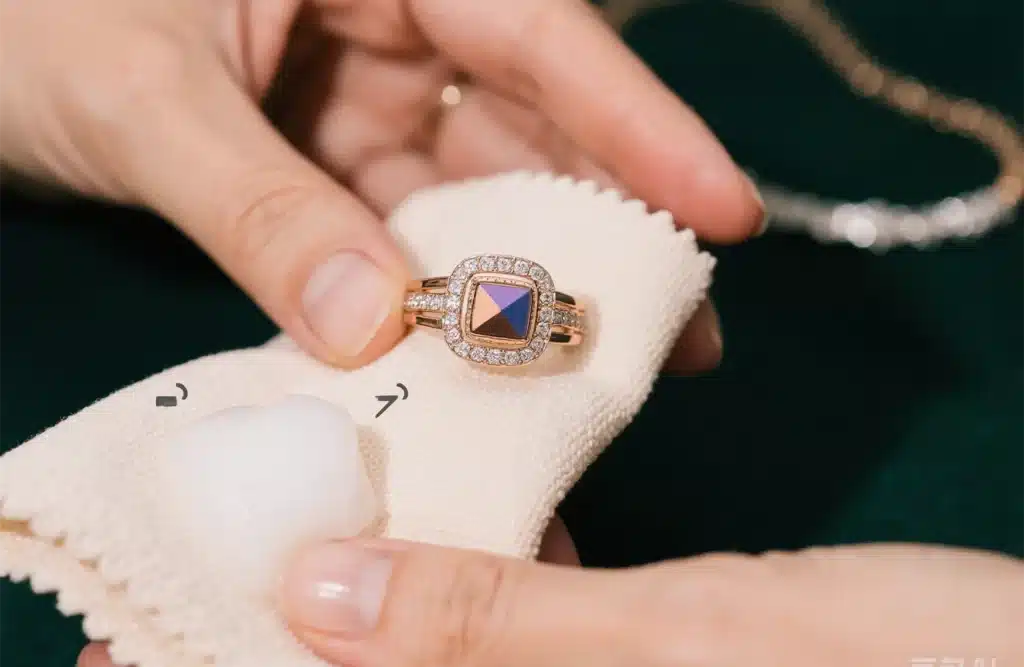
As with any jewelry, clean your PVD pieces with very mild soap diluted in warm water and a soft cloth. Rinse well and dry with a gentle touch.
Skip harsh brushes or scouring pads. Try to clean each piece at least once or twice a month, or more frequently for something you wear every day.
The finish is durable, but you can help maintain your jewelry by avoiding harsh soaps and chemicals. A non-abrasive soft cloth will not scratch the finish.
Cleaning regularly prevents dirt from ruining the shine, and maintaining a schedule ensures that your jewelry is long lasting.
Avoid Harsh Chemicals Exposure
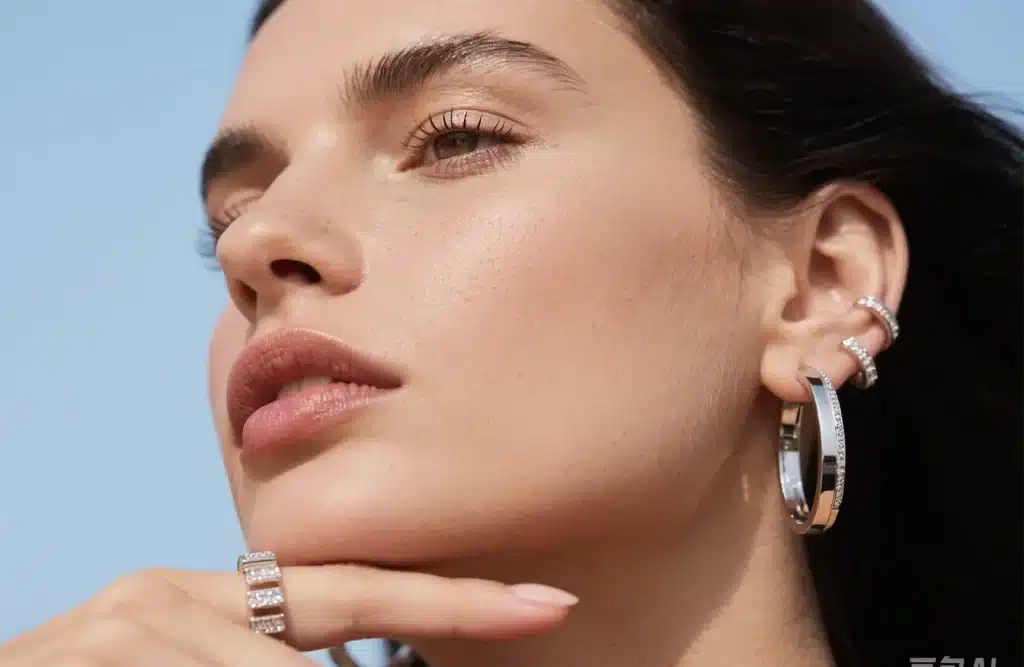
Keeping your PVD jewelry away from harsh chemicals is essential. Ammonia, bleach, and a lot of other jewelry cleaners will damage the coating as well.
Be careful with hair sprays, perfumes, and cleaning sprays. These can accelerate wear on your jewelry. Avoid harsh chemicals like bleach.
If you require a bit more, look on the label to ensure what you’re using is safe for plated metals.
Store Your Pieces Smartly
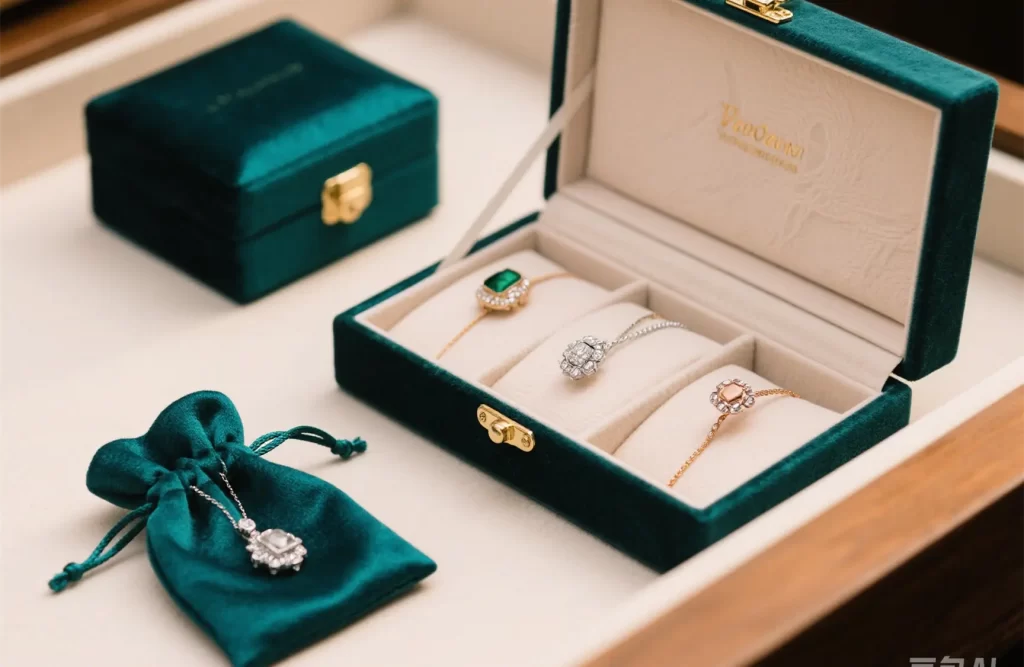
Use a fabric-lined jewelry box or pouch. Store pieces apart to stop scratching. Keep them dry and out of direct sunlight.
Avoid humid spots like bathrooms. Proper storage prevents air and moisture from causing unnecessary wear to the coating.
At HonHo, we’re committed to using quality materials so our PVD jewelry stands the test of time, but storing your pieces smartly makes a difference, too.
My Verdict: Is PVD Worth It?
For anyone looking for an affordable, stylish, and long-lasting jewelry option, PVD jewelry is worth it. Oh, and it’s pretty darn inexpensive too! PVD (Physical Vapor Deposition) coating provides the highest level of wear and scratch resistance. It far exceeds the performance of gold plating or simple stainless steel.
Though no form of jewelry is completely impervious, the majority of PVD-coated pieces resist wear and tear for up to three years with regular wear. If you treat them well—put them in the right climate, avoid moisture, avoid corrosive chemicals—some can last 30 years or more. To customers who are looking for affordable, everyday jewelry that lasts, that’s real value.
Assessing True Value for Money
To see if you’re getting your money’s worth, see how long PVD jewelry stands up to wear. Next, weigh that durability against its initial cost. Considering that PVD can be considerably more expensive than traditional plating, you’ll actually spend less over time because it’s more durable and needs to be repaired or replaced less often.
For instance, a basic gold PVD chain will hold its luster considerably longer than a gold-plated chain. What’s more, it’ll be more scratch resistant, to boot, all while costing about the same. When you are shopping, test to see that the item is heavy duty and search for brands with positive feedback. Not all PVD jewelry is created the same—while quality varies, most high-quality pieces are chip- and fade-resistant.
Who Benefits Most from PVD?
PVD jewelry is a perfect choice for the active lifestyle or adventurous spirit who’s always looking to reinvent their style. That’s awesome if you need contemporary, no-muss, no-fuss looks for the office, brunch, or wedding season.
Fashion-forward testers especially liked that it was available in several trendy finishes, including gold, black, or rose. Whether it’s a wedding, work party, or just going about your business, PVD pieces are sure to impress while being durable enough to withstand your day-to-day adventures.
Why I Often Recommend PVD
Why I frequently recommend PVD? Good looks aside, PVD is extremely durable. Nearly all of our customers report that their PVD jewelry remains shiny and does not dull or scratch easily.
It’s what today’s homebuyers are clamoring for —something that looks great, stands the test of time, and saves them money in the long run.
Popular PVD Jewelry Styles Now
PVD jewelry has revolutionized our perception of beauty and utility in everyday clothing. With so many options on the market, people in Los Angeles and beyond are leaning toward pieces that balance appeal with real-life needs. Thanks to the physical vapor deposition process, we can now find jewelry available in techniques that come in all kinds of great colors.
No longer is gold and silver the only option! Warm rose gold, deep gunmetal, rich black, and even vibrant blues and purples are readily available. In addition, this technology allows each piece to retain its color and luster for an extended period of time. PVD coatings are 30% to 70% more durable than conventional plating.
The patented PVD process results in jewelry that is extremely scratch and corrosion resistant. This added durability is ideal for those who work or recreate in tropical coastal cities.
Everyday Chains and Rings
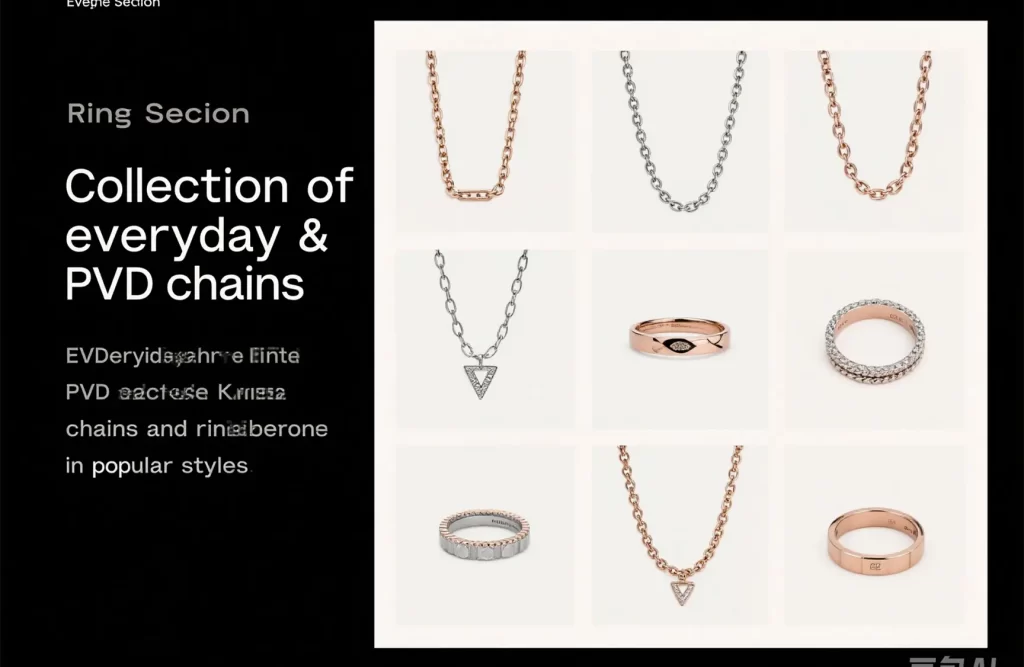
Everyday chains and rings, made in popular PVD colors, are a huge trend right now. Many customers opt for stainless steel jewelry or titanium bases, both of which are hypoallergenic and excellent for sensitive skin. These jewelry pieces are surprisingly sturdy, even when worn all day, every day, thanks to the advanced coating technology used in the PVD coating process.
Women love these items because they combine simple, minimalist styling with the ability to withstand moisture and everyday use. A thin gold chain or matte black ring looks as good with denim as it does with a suit, making them a staple in any jewelry collection.
This unique blend of aesthetics and durability ensures that one collection of jewelry can easily transition from day to night, showcasing the exceptional hardness and resistant finish of modern coating processes.
Bold Black PVD Pieces
In fact, black PVD jewelry is one of the hottest trends. Its PVD color isn’t shy, but it’s so deep and rich that it doesn’t feel ostentatious. Consider wide black cuffs, heavy signet rings, or large hoop earrings.
These dramatic PVD statements definitely catch the attention and make even a simple look appear super sleek. The hard black color is pretty scratch resistant too. That’s ideal for wearers who want to invest less time cleaning their pieces and more time enjoying them!
Warm Gold and Rose Tones

Warm gold and rose colored PVDs are now the go-to favorites for all of life’s special occasions. These warm shades are universally flattering on all skin tones and really glow beautifully under any soft lighting.
Such as rose gold charm bracelets or classic yellow gold necklaces for homecoming or date night. No wonder folks are drawn to these warm hues, which provide a cozy, luxe aesthetic with less concern over quick wear down or tarnishing.
Future Trends in PVD Jewelry
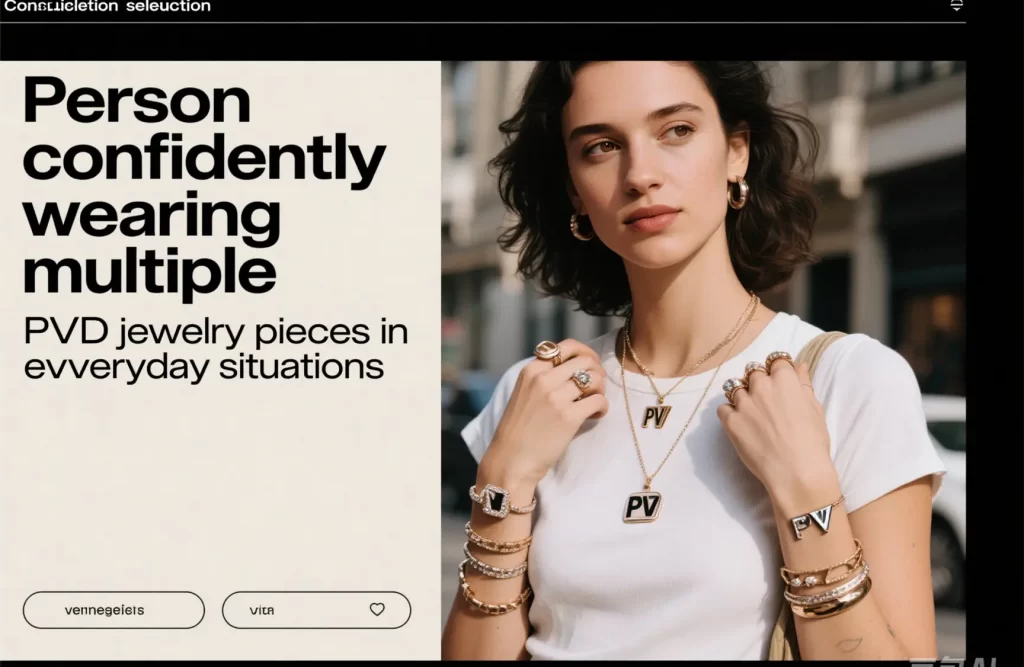
PVD jewelry continues to be leading edge in transformation of the jewelry industry. In fact, a few years from now, I see growth fueled by new technology and consumer preference hand in hand. Market data shows a 15% jump in demand in just the last five years.
This increase is due to the remarkable durability and aesthetic beauty of these products. Today, consumers are increasingly seeking out sustainable options, and unlike traditional plating methods, PVD coating offers a more sustainable solution that caters to this demand.
That’s because this change is not just changing what you want. It’s shaping the types of things that designers and makers, such as us at HonHo, are producing. New coating technologies are being introduced, providing you wider options in look, hue, and durability.
This is why PVD has become a go-to option for fine jewelry and fashion jewelry alike.
Exciting New Color Options
One of the most exciting aspects of PVD jewelry is the rapidly expanding color palette. New tech lets us offer bright blues, deep greens, rich rose golds, and even bold blends like black and gold or rainbow effects.
These options allow us to cater to the different preferences of color that our buyers want. For example, customers today request a lot more custom colors that suit their individual style or special occasions.
This trend gives you ways to stand out, whether you want a classic look or something that breaks the mold.
Enhanced Coating Technologies
The coating technology used in PVD jewelry continues to improve. Innovative techniques ensure that each piece is as durable as it can be, standing up to everyday life without tarnishing or fading.
That translates to you receiving jewelry that will continue to look beautiful for many years, even under the harshest of uses. As these techniques continue to improve, look for more intricate and elaborate designs that not long ago seemed impossible.
For you, this translates into better options with more enduring quality and elegance.
Conclusion
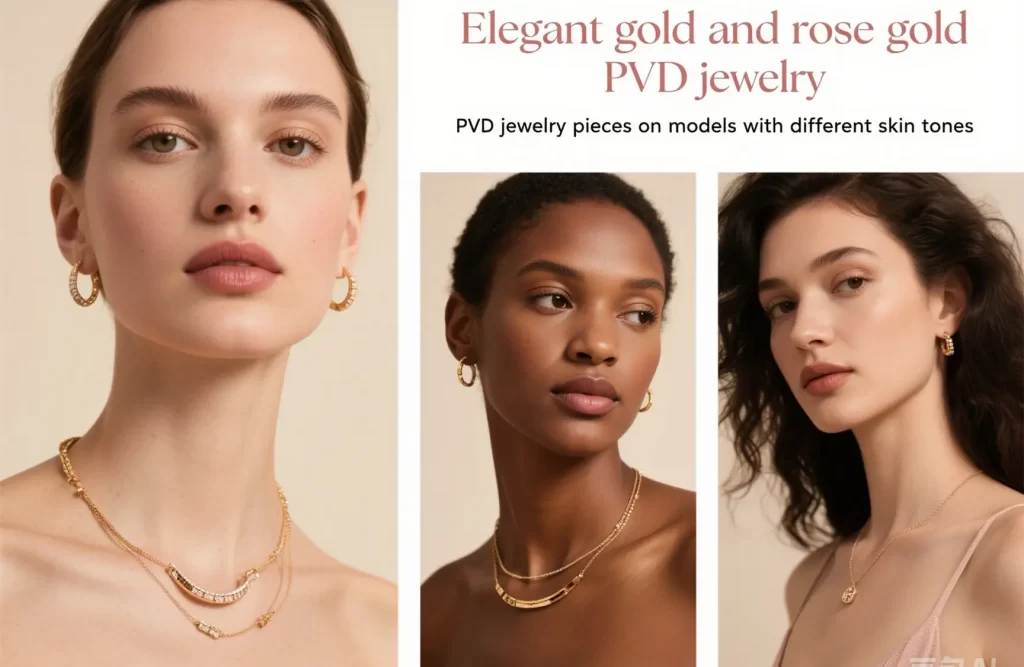
PVD jewelry provides me with the opportunity to wear statement pieces that can stand up to living life. The joy of this is that I don’t have to worry about tarnish or color fading. With PVD, my rings continue to shine brightly after a long day at work or a night out in LA. I see gold chains, hoop earrings, and even chunky bracelets that go with the streets to the corporate world.
PVD is ahead of the curve with innovative designs and hip trends, and it holds up amazing on my skin. If you’re looking for jewelry that doesn’t tarnish easily and continues to look fresh, PVD is a winner. Experiment, discover what works best for your aesthetic, and allow your own everyday to reveal the power. Have any other questions or want to share your discovery with us? Leave a note below and join the discussion.
Frequently Asked Questions
What does PVD mean in jewelry?
PVD, or Physical Vapor Deposition, is an advanced coating technology that applies a long-lasting, tarnish-resistant layer to jewelry pieces, enhancing their durability and helping them maintain a pristine appearance over time.
Is PVD jewelry safe for sensitive skin?
Is PVD jewelry safe for sensitive skin? The pvd coating process works like a protective shield, preventing potential contact with base metals that could cause skin irritation, making it safe for everyone to wear.
How long does PVD jewelry last?
Under normal fashion jewelry-wearing conditions, quality PVD jewelry can last for years. The PVD coating process is several times more durable than traditional gold plating, helping to resist scratches, fading, and tarnishing.
Can PVD jewelry get wet?
Can PVD jewelry get wet? The advanced coating technology of PVD ensures it holds up to water, sweat, and chemicals better than standard plated jewelry, making it ideal for everyday wear.
How do I clean my PVD jewelry?
Step 1—Wash with warm mild soap. Avoid cleansers that contain acids or harsh chemicals, as they can damage the jewelry surface. Gently wipe down with a soft cloth to maintain the pristine appearance of your jewelry pieces, ensuring the resilient coating remains intact.
Is PVD coating better than gold plating?
Is the PVD coating process better than traditional gold plating for everyday jewelry?
Does PVD jewelry tarnish or fade?
PVD jewelry features a resilient coating that does not tarnish or fade easily, ensuring that jewelry pieces maintain their bright color and shine far longer than traditional gold plating.
Related Posts
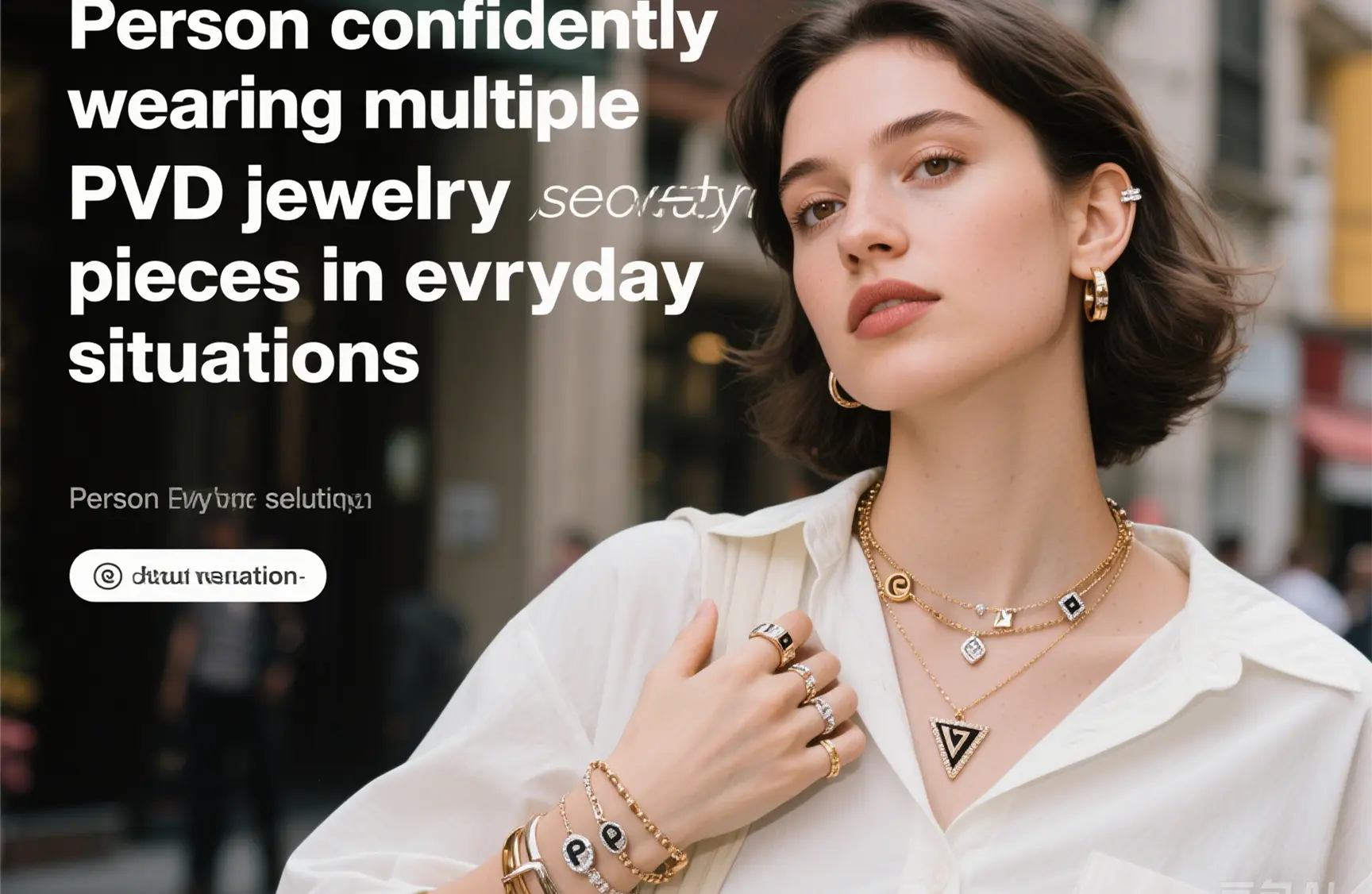
PVD Jewelry: Understanding the Benefits and Drawbacks
PVD refers to the process of applying a hot, strong coating to jewelry that is known as physical vapor deposition. I work through this process

